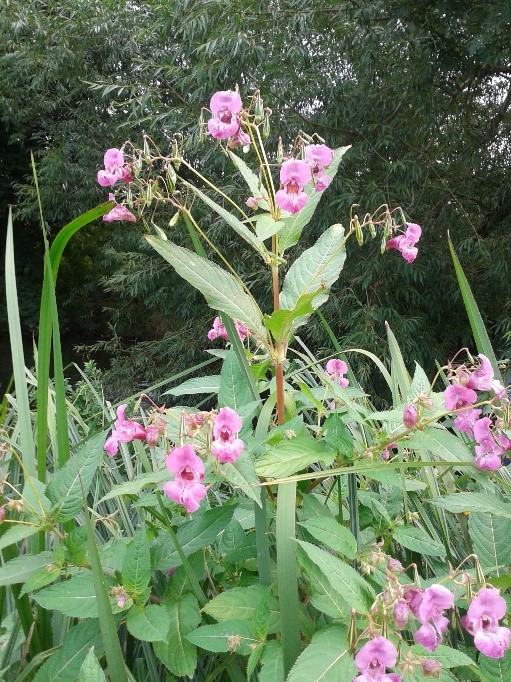
Himalayan Balsam’s beautiful pink flowers appear between June and September. We take a look at Himalayan balsam (Impatiens glandulifera), one of the UK’s most invasive and problematic weed species, and the work CABI is doing to combat its spread.
Why is Himalayan balsam such a big problem?
Colonising rail and river banks, wastelands and woodlands, Himalayan balsam was introduced to the British Isles in 1839 by Victorian plant hunters who were keen on its beautiful pink flowers and exploding seed pods. The plant has had plenty of time to establish in the UK and, over the last 50 years, has spread rapidly.
But Himalayan balsam is a problematic plant. It competes with native plants for light, nutrients, pollinators and space, excluding other plants and reducing biodiversity. It dies back in the winter, leaving river banks bare and open to erosion. Dead leaves and plant debris from the weed block waterways and lead to flooding.
Traditional ways of controlling the plant, either by pulling it up or spraying it with chemicals, don’t or can’t always work, because the plant often grows in difficult to reach places and delicate river sites. And it spreads quickly. Like most non-native plant species, Himalayan balsam arrived in the UK without any of the natural enemies that keep it in check in its native range – in this case, the foothills of the Himalayas in Pakistan and India, and western Nepal. Without these natural enemies, the plant has an advantage over native species and grows more aggressively than it normally would.
It’s also expensive to manage. In 2003, the Environment Agency estimated it would cost £300 million to eradicate Himalayan balsam from the UK entirely.

What’s CABI doing to solve the problem?
In 2006, CABI started the process of looking for natural enemies to control Himalayan balsam. By 2010, a highly selective rust fungus, Puccinia komarovii var. glanduliferae, was found to damage Himalayan balsam and no other native species and, in 2015, a strain of the rust fungus originating from India was approved for release. It became the first fungal agent to be used as a classical biological control agent against a weed in Europe. Initially, the fungus was released at a number of trial sites in the UK and later, over the course of 2015-2019, at a total of 47 sites in 19 counties in England and Wales.
CABI scientists Dr Carol Ellison, Kate Pollard and Sonal Varia explain their work to find a natural way to control Himalayan balsam in their paper Potential of a coevolved rust fungus for the management of Himalayan balsam in the British Isles: first field releases published in Weed Research in January 2020.
They describe some interesting findings.

Not all Himalayan balsam is the same
Interestingly, the rust fungus didn’t infect plants at all the Himalayan balsam sites in 2015, despite showing success in the lab. CABI started to look at why this might be. Inoculation experiments in controlled conditions revealed that some Himalayan balsam plants could be infected by the rust fungus, while some were immune.
As a result, a second strain of the rust – this time from Pakistan, not India – was released in 2017. This strain infected a different group of Himalayan balsam plants. Scientists realised that Himalayan balsam must have been introduced from different regions at different times and, therefore, needed different strains of the rust fungus to control them. Efforts are ongoing to obtain additional rust strains from other parts of the native range.
The environment affects how the rust fungus spreads…
For the rust fungus to become part of the local ecosystem and control Himalayan balsam naturally on its own, it needs to survive in the soil during the British winter and infect new balsam seedlings in the spring. Its ability to do this depends on a number of things, including its environment.
In the paper, it’s explained how, “Shade was found to be an important factor limiting both the incidence and the severity of the rust infection at the selected sites.” It’s possible that the less light a Himalayan balsam plant has access to, the fewer nutrients it will produce to support the rust fungus, making it more difficult for the fungus to overwinter. Light and shade could be important factors determining how effective it is at infecting Himalayan balsam.
…and spraying helps too
In 2015, scientists released the rust fungus by placing infected plants among large patches of existing Himalayan balsam. The wind spread the rust fungus naturally. However, CABI scientists discovered that applying the fungus with a spray solution was a more effective method of achieving greater levels of rust infection and, from 2017, this become the way the rust was released.
Dr Ellison and her team say evidence of the impact of the rust fungus on Himalayan balsam is “the critical issue” and that measuring this is likely to take a number of years. The team continue to work with partners in India and work with organisations like river trusts and water authorities to further release the rust fungus. CABI’s work continues.
Read the full paper: Potential of a coevolved rust fungus for the management of Himalayan balsam in the British Isles: first field releases
Read our project page on Himalayan balsam

This article is published in memory of Dr Carol Ellison who recently passed away after a prolonged illness. Carol was an exceptional and dedicated scientist who was passionate about plant pathology and weed biocontrol and cared deeply about her work. She was a tremendous contributor, mentor and coach to CABI’s science team and to our broader work on invasive species. She leaves a legacy of significant scientific achievement on weeds such as Mikania and Himalayan balsam, as well as having trained a strong cohort of talented successors.
8 Comments
Leave a Reply
Related News & Blogs
Biological control in action: Zambia’s field days on fighting fall armyworm
Experts from CABI recently held two field days and an expo in Zambia, showcasing innovative approaches to pest management to 584 farmers, agro-dealers and other stakeholders to help raise awareness of approaches to tackle the invasive fall armyworm (Sp…
11 June 2025





Very interesting, thanks. Is it possible to obtain/ buy inoculum of the rust fungus? I have a 23 acre smallholding near Abergavenny which is heavily colonised by Himalayan Balsam and have failed to control it by a combination of hand pulling and herbicide spraying.
Hi Richard, thank you for your message. I don’t believe this is available yet as the blog is based on a research paper. You may find this link useful for further information on Himalayan Balsam: https://www.cabi.org/isc/datasheet/28766#topreventionAndControl
Kind regards, Laura
Very many thanks Laura. Interesting reading and more detailed than anything I’ve seen before. Do you know how I would find out if it becomes available to purchase and where from?
Have you tried contacting the local environment agency for advice /help?
How does it effect the Native touch me not balsam ??
Hi Eddie, thanks for your question. It does not affect the native Impatiens species. The CABI team tested Impatiens noli-tangere with the rust and it was unaffected. They tested two populations, one from the Lake District and one from Wales. The rust is very much specific to Himalayan balsam.
Our local river course was almost obliterated with H Balsam. We simply clouted its stems with hoes and rakes before it came into flower and left the dying plants in situ (as pulling it would have destabilised the banks). This almost totally eradicated it in two years. It is free, fun and rather satisfying to do.
Interestingly, the Himalayan Balsam is much less of a problem now. I have given up control measures several years ago, We now have donkeys grazing the fields as well as the horse. They eat the Himalayan Balsam and have virtually eradicated it even amongst dense bracken. In the woodland where the donkeys do not have access the weed persists, but much weaker than before. It’s possible that the shade cast by the woodland trees might be stronger [the woodland is now about 25 years old], but could there be another reason? I hope this observation might be helpful.
Richard [“chipinge”]